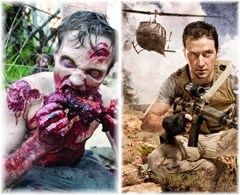2011 Fall TV Body Count Study Results
Summary, Background & Methodology
Published: May 21, 2012
| New Study for 2012 |
|---|
 See the results of our Fall 2012 TV Body Count Study. See the results of our Fall 2012 TV Body Count Study. |
Have you ever thought about how many people die in the TV shows you watch every week? Do you notice many funerals? Funeralwise wanted to look at the role of death in popular culture, more specifically in broadcast and cable shows. The following results are reported after evaluating over 300 recently aired episodes.
Summary of 2011 TV Body Count Results
 The Starz series Spartacus: Vengeance topped all shows with an average of 25 dead bodies per episode, followed by HBO’s Game of Thrones with 14 dead bodies per episode. The Starz series Spartacus: Vengeance topped all shows with an average of 25 dead bodies per episode, followed by HBO’s Game of Thrones with 14 dead bodies per episode. |
 The deadliest broadcast network show was The CW’s Nikita, with nine dead bodies per episode. The CBS series NCIS: Los Angeles was the second deadliest, with an average of 6 dead bodies per episode. The deadliest broadcast network show was The CW’s Nikita, with nine dead bodies per episode. The CBS series NCIS: Los Angeles was the second deadliest, with an average of 6 dead bodies per episode. |
 CBS was the deadliest network due to having 11 shows selected for the study, by far the most of any network. Five (5) CBS shows were among the top 10 deadliest. CBS was the deadliest network due to having 11 shows selected for the study, by far the most of any network. Five (5) CBS shows were among the top 10 deadliest. |
 The deadliest shows for non-human creatures were The CW’s The Vampire Diaries, with 18 dead vampires per episode, and AMC’s The Walking Dead, with 16 dead zombies per episode. The deadliest shows for non-human creatures were The CW’s The Vampire Diaries, with 18 dead vampires per episode, and AMC’s The Walking Dead, with 16 dead zombies per episode. |
 The “safest” shows for humans and other creatures were ABC’s Revenge, TNT’s Leverage, and USA’s White Collar, all of which had no dead bodies in the eight episodes analyzed. The “safest” shows for humans and other creatures were ABC’s Revenge, TNT’s Leverage, and USA’s White Collar, all of which had no dead bodies in the eight episodes analyzed. |
 The 40 TV series analyzed averaged 132 dead bodies, in total, during a single week for an average of more than three dead bodies per episode. Including non-humans, the figure rises to 171 dead bodies per week. The 40 TV series analyzed averaged 132 dead bodies, in total, during a single week for an average of more than three dead bodies per episode. Including non-humans, the figure rises to 171 dead bodies per week. |
 Very few funerals were shown during the programs Funeralwise.com analyzed. Of the 300+ episodes counted totaling 1,000+ dead bodies, there were only eight instances where some funeral or memorial service was conducted. Very few funerals were shown during the programs Funeralwise.com analyzed. Of the 300+ episodes counted totaling 1,000+ dead bodies, there were only eight instances where some funeral or memorial service was conducted. |
 What constitutes a dead body on television is not straightforward. When analyzing television programs to determine body count, watchers often had difficulty determining if a body should be included. What constitutes a dead body on television is not straightforward. When analyzing television programs to determine body count, watchers often had difficulty determining if a body should be included. |
 Many of the shows that regularly display dead bodies are popular with viewers. However, there does not appear to be a direct correlation between the number of dead bodies shown in a program and the number of viewers who watch the program. Many of the shows that regularly display dead bodies are popular with viewers. However, there does not appear to be a direct correlation between the number of dead bodies shown in a program and the number of viewers who watch the program. |
Background
The idea for this study evolved from a shoot-out scene on a popular television crime show. After watching this scene, Funeralwise managing partner, Rick Paskin, commented to his wife, “They kill lots of people on this show every week.” That started him thinking about death as it is portrayed on television. Seeking to better understand the public’s acceptance of death as entertainment, he decided to commission the study.
Funeralwise.com’s TV Body Count Study aims to quantify death’s role in popular culture by analyzing the portrayal of dead bodies on television shows.
- Do we find death entertaining?
- How do portrayals of death affect the popularity of entertainment programs?
- Can the acceptance of death in entertainment programming make it easier to accept the reality of our mortality?
Funeralwise.com seeks to answer these and other questions about the role of death in modern society. Ideally, the results of this study will stimulate a dialogue about our view of death and how we should prepare for it.
The following discusses how Funeralwise.com collected data and what the data showed.
Methodology
For this study, Funeralwise chose to focus on television because of its popularity with all age groups. The study was designed to determine the presence of death in TV shows by counting dead bodies appearing in the shows. Forty (40) television series were selected for analysis. The study was conducted in the first four months of 2012 and analyzed eight recently aired episodes of each series.
Funeralwise emphasizes that the study was not statistically based. The methodology was to count the number of dead bodies shown in individual episodes of popular television programs, regardless of the manner of death. The counts included humans and non-humans (i.e., vampires, werewolves, shape-shifters, undead, etc.) and funerals. The shows selected for the study were judged to have content that regularly included the presence of dead bodies. The programs included those shown on “free” broadcast channels such as ABC, CBS, and NBC, standard cable channels such as USA and TNT, and premium channels such as HBO and Showtime. No attempt was made to balance the number of shows by the network.
To accomplish the study, four key steps were necessary:
-
- Select the programs to analyze. Funeralwise reviewed a listing of the programs that currently air during prime-time viewing hours. The programs were selected based on the content they had presented in the past. More specifically, these are programs where it is not unusual to see a dead body or someone killed. Network representation was not a significant consideration. Accordingly, the number of shows selected varied from network to network. Also, there was no attempt to compare the shows within the same broadcast time slots.The programs to be included in the study are shown in the following table.
TV Series Included in the Study
| Broadcast |
|---|
| Body of Proof (ABC) |
| Castle (ABC) |
| Revenge (ABC) |
| Blue Bloods (CBS) |
| Criminal Minds (CBS) |
| CSI: Crime Scene Investigation (CBS) |
| CSI Miami (CBS) |
| CSI New York (CBS) |
| Hawaii Five-O (CBS) |
| NCIS (CBS) |
| NCIS Los Angeles (CBS) |
| Person of Interest (CBS) |
| The Mentalist (CBS) |
| Unforgettable (CBS) |
| Alcatraz (FOX) |
| Bones (FOX) |
| Fringe (FOX) |
| Grimm (NBC) |
| Law & Order: Special Victims Unit (NBC) |
| The Vampire Diaries (CW) |
| Nikita (CW) |
| Supernatural (CW) |
| Cable |
|---|
| Breaking Bad (AMC) |
| The Walking Dead (AMC) |
| Flashpoint (ION) |
| Justified (FX) |
| Leverage (TNT) |
| Rizzoli & Isles (TNT) |
| Southland (TNT) |
| The Closer (TNT) |
| Burn Notice (USA) |
| Covert Affairs (USA) |
| In Plain Sight (USA) |
| White Collar (USA) |
| Premium Cable |
|---|
| Boardwalk Empire (HBO) |
| Game of Thrones (HBO) |
| True Blood (HBO) |
| Dexter (Showtime) |
| Homeland (Showtime) |
| Spartacus: Blood and Sand (Starz) |
-
- Enlist “watchers.” At least two watchers were planned for each series to provide as much accuracy as possible. Where there were inconsistencies in the counts, a third watcher would be assigned to confirm the counts. Watchers were provided a small stipend to compensate them for their time. To find individuals willing to participate in the study, Funeralwise posted “help wanted” advertisements on its website and Facebook page. It also posted requests for “watchers” in forums for the networks and the individual programs. Individuals from Funeralwise.com were also recruited to help. In all, 18 watchers participated in the study, with most providing body counts for more than one series.
- Count the bodies. Each watcher was provided with guidelines to help determine what should be included in the body count. Below are the instructions that each watcher received.
What do we count?
-
- We count the number of dead bodies appearing in the episode. A body is counted only once, even if it appears in more than one scene.
- We separately count the number of “undead” creatures such as vampires, zombies, werewolves, shape-shifters, and any formerly living or human-like creatures. If you are not sure, count it and describe what it is.
- We do not count dead animals.
- We do not care how the character dies and do not need to see the character die on screen. WE are simply counting dead bodies that appear in the episode.
- We do not need confirmation that a character is dead. If characters appear dead and we do not subsequently learn in the episode that they survived, we’ll assume they are dead.
- If a funeral is held for a dead character, we count it.
- Compile and analyze the results. Watchers were provided with a form to complete after counting an episode. These forms were submitted electronically. Upon receipt, the counts were input into a database. As the results were being tabulated, quality control checks were conducted. Where there were inconsistencies, the watchers were requested to clarify their responses. In cases where counts could not be reconciled, a third watcher was enlisted to confirm the counts. After the data collection, all the results were tabulated and analyzed.
Continue Reading: TV Body Count Study Challenges & Results >>

